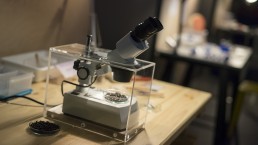ARCHEOBOTANY LAB
People of Çatalhöyük consumed emmer, einkorn, barley, peas, bread wheat (tiriticum aestivum), lentil, and types of vetch (vicia noena, ervum ervilia) along with fruits and nuts such as almond, acorn, peanut (pistachio atlantica), apple, juniper and hackberry (celtis australis).
They carried billets from faraway lands and used them for both fuel making and architecture. These are just some of the results of the studies of archaeobotanists who are investigating 9000-year-old recipes, whether seeds were planted or food was gathered, and so forth.
The floatation, or wet-sieving, technique used during excavations involves the separation of the soil through a sieve with 4-mm mesh. In addition, the soil is divided into piles of a maximum of 30 liters and placed to be floated. Materials that end up floating on the surface include carbonated plants called the light residue; materials that sink through 4-mm mesh are the heavy residue.
Later, heavy residues are dried and divided into three groups depending on their size: larger than 4mm, 4mm to 2mm, and smaller that 1mm. Every pile is examined to determine the intensities of artefactual

